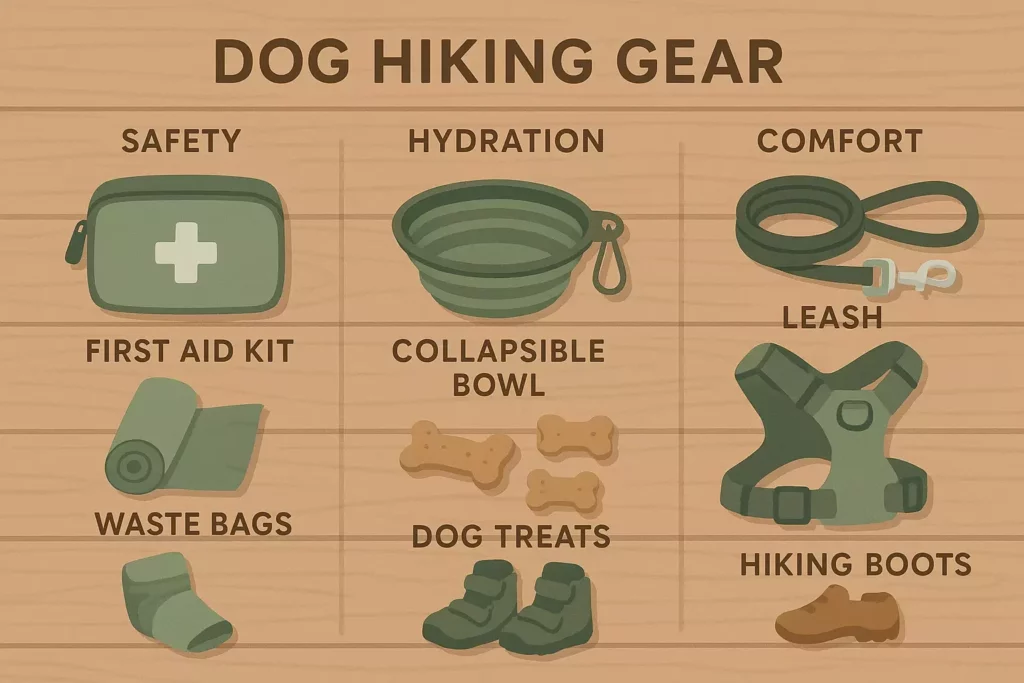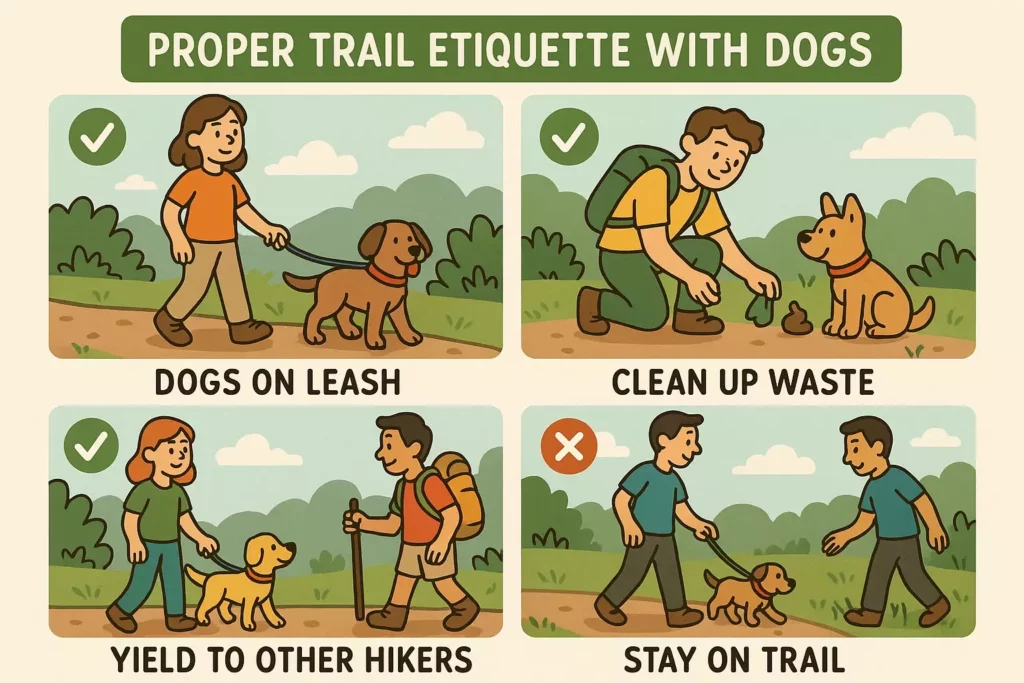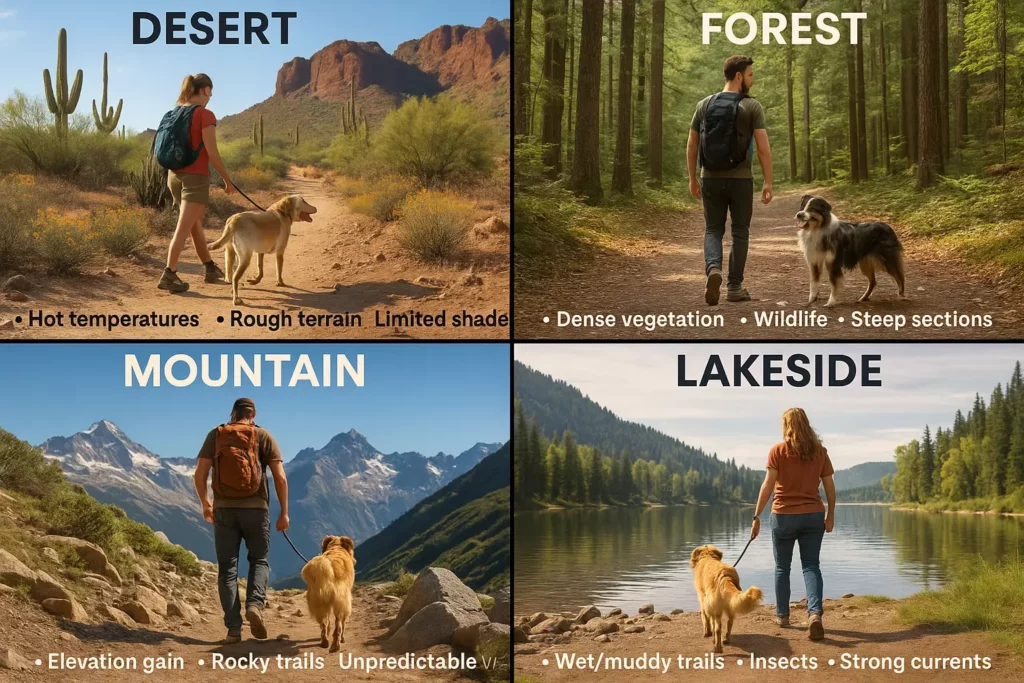Paws on the Path: How to Find Dog-Friendly Hiking Trails Near You
Picture this: your furry companion’s tail wagging with pure joy as they bound along a scenic mountain trail, their nose twitching at every new scent while you both soak in breathtaking views together. Dog-friendly hiking isn’t just exercise—it’s an adventure that strengthens the bond between you and your four-legged friend while exploring nature’s wonders. In 2025, more hikers than ever are discovering that the best hiking companion might just be the one waiting by your front door with a leash in their mouth.

Key Takeaways
- Research is essential: Use specialized apps, websites, and local resources to identify truly dog-friendly trails with proper amenities
- Preparation matters: Pack essential supplies including water, waste bags, first aid items, and appropriate gear for both you and your dog
- Trail etiquette saves the day: Follow leash laws, clean up after your pet, and respect wildlife to ensure continued trail access for all dog owners
- Safety comes first: Check trail conditions, weather forecasts, and your dog’s fitness level before heading out
- Start small and build up: Begin with shorter, easier trails to assess your dog’s hiking abilities before tackling more challenging adventures
Why Dog-Friendly Hiking Is More Popular Than Ever 🐕
The surge in dog-friendly outdoor activities reflects a growing understanding of the mutual benefits these adventures provide. Dogs need regular exercise to maintain physical and mental health, while humans crave outdoor experiences that reduce stress and improve well-being. When combined, hiking with dogs creates a perfect synergy.
Benefits for dogs include:
- Enhanced cardiovascular fitness
- Mental stimulation from new environments
- Socialization opportunities
- Reduced behavioral problems from adequate exercise
Benefits for humans include:
- Increased motivation to exercise regularly
- Enhanced outdoor experiences through a dog’s perspective
- Stronger human-animal bonds
- Built-in hiking safety companion
Essential Research Tools for Finding Dog-Friendly Trails
Digital Resources and Apps 📱
AllTrails remains the gold standard for trail research, featuring detailed filters for dog-friendly options. The app provides:
- User reviews specifically mentioning dogs
- Trail difficulty ratings
- Real-time conditions updates
- Downloadable offline maps
BringFido specializes exclusively in pet-friendly locations, offering:
- Comprehensive trail databases
- Local pet policy information
- User-submitted photos of dogs on trails
- Integration with pet-friendly accommodations
iOverlander and Campendium help locate nearby camping options if planning overnight adventures with proper shelter setup.
Local Government Resources
National Park Service websites provide official pet policies for each location. While many national parks restrict dogs to paved areas, some offer excellent dog-friendly trails.
State park systems often provide more flexible pet policies. Research individual state websites for:
- Specific trail designations
- Leash requirements
- Seasonal restrictions
- Required permits or fees
County and municipal parks frequently offer the most dog-friendly options with fewer restrictions.
Community-Based Information Sources
Local hiking groups on Facebook and Meetup often share insider knowledge about:
- Unofficial dog-friendly trails
- Seasonal access changes
- Trail condition updates
- Group hiking opportunities
Veterinary clinics and pet stores maintain bulletin boards with local outdoor activity information.
Dog training facilities and doggy daycares staff frequently hike with clients’ pets and possess valuable local knowledge.
Understanding Trail Classifications and Restrictions

Leash Requirements and Regulations
On-leash trails require dogs to remain leashed at all times, typically with maximum leash lengths of 6 feet. These trails offer:
- Better wildlife protection
- Increased safety for all trail users
- Easier waste management
- Compliance with most local regulations
Off-leash designated areas allow dogs to roam freely within specified boundaries. These areas require:
- Excellent voice control training
- Higher owner responsibility
- Careful consideration of other trail users
- Understanding of wildlife risks
Seasonal and Environmental Restrictions
Summer restrictions often protect wildlife during breeding seasons or prevent heat-related pet injuries.
Winter considerations include:
- Trail accessibility
- Cold weather gear requirements
- Shorter daylight hours
- Ice and snow hazards
Fire season closures may temporarily restrict access to prevent additional ignition sources.
Essential Gear for Dog Hiking Adventures
For Your Canine Companion
Proper collar and leash setup:
- Sturdy, well-fitting collar with ID tags
- 6-foot leash for most trail situations
- Backup leash for emergencies
- Consider a harness for better control
Hydration and nutrition:
- Collapsible water bowls
- Extra water (dogs need more than humans realize)
- High-energy treats for motivation
- Emergency food supplies
Safety equipment:
- LED collar light for visibility
- Reflective vest for dawn/dusk hiking
- Basic first aid supplies including pet-specific items
- Booties for rough terrain protection
For Human Hikers
Navigation tools:
- GPS device or smartphone with offline maps
- Physical map and compass backup
- Emergency whistle
- Headlamp with extra batteries
Personal safety gear:
- Properly packed hiking backpack
- Weather-appropriate clothing
- Emergency shelter materials
- Water purification methods
🐕 Dog-Friendly Trail Finder
Finding trails near you…
Recommended Trails
Trail Etiquette and Responsible Hiking Practices
The Golden Rules of Dog Hiking 🌟
Always clean up after your pet. Pack extra waste bags and carry them out—never leave them on the trail, even temporarily. This simple act preserves trail access for future dog hikers.
Respect leash laws even if your dog has excellent recall. Other hikers, wildlife, and even your own pet’s safety depend on following posted regulations.
Yield the right of way appropriately:
- Dogs and owners should step aside for horses
- Allow faster hikers to pass
- Keep dogs close when encountering mountain bikers
Control your dog’s interactions with other hikers, dogs, and wildlife. Not everyone loves dogs, and some people have fears or allergies.
Wildlife Considerations
Protect local ecosystems by preventing your dog from:
- Chasing wildlife
- Disturbing nesting areas
- Drinking from sensitive water sources
- Straying from designated trails
Understand seasonal wildlife patterns such as:
- Bird nesting seasons
- Bear activity periods
- Snake emergence times
- Migration corridors
Safety Considerations for Dog Hiking

Pre-Hike Health Assessment
Veterinary clearance ensures your dog is physically capable of hiking demands. Discuss plans with your veterinarian, especially for:
- Senior dogs
- Puppies under 18 months
- Dogs with health conditions
- Breeds prone to breathing difficulties
Fitness evaluation should include:
- Current exercise tolerance
- Paw pad condition
- Joint health assessment
- Weight management status
Weather and Environmental Hazards
Hot weather precautions:
- Hike during cooler morning or evening hours
- Test pavement temperature with your hand
- Provide frequent water breaks
- Watch for signs of overheating
Cold weather considerations:
- Appropriate clothing protection for both species
- Paw protection from ice and salt
- Shorter hiking durations
- Emergency warming supplies
Common trail hazards include:
- Poisonous plants (poison ivy, wild mushrooms)
- Dangerous wildlife encounters
- Unstable terrain
- Fast-moving water crossings
Emergency Preparedness
Create an emergency action plan including:
- Emergency contact information
- Nearest veterinary clinic locations
- Trail evacuation routes
- Comprehensive first aid supplies
Learn basic pet first aid techniques such as:
- Wound cleaning and bandaging
- Signs of heat exhaustion
- Choking response procedures
- Carrying techniques for injured dogs
Building Your Dog’s Hiking Fitness
Progressive Training Approach
Start with short, easy walks on familiar terrain to assess your dog’s baseline fitness and interest level.
Gradually increase distance and difficulty following the 10% rule—increase weekly mileage by no more than 10% to prevent injury.
Practice trail skills including:
- Walking on leash without pulling
- Responding to recall commands
- Navigating obstacles safely
- Resting on command
Conditioning Exercises
Paw pad strengthening occurs naturally with increased walking on varied surfaces. Begin with short sessions on different textures.
Cardiovascular conditioning develops through consistent, moderate exercise rather than sporadic intense activity.
Mental preparation includes exposing dogs to:
- Different environments and sounds
- Various weather conditions
- Other hikers and dogs
- Wildlife scents and sights
Planning Multi-Day Adventures
Overnight Considerations
Campground research requires finding pet-friendly accommodations with appropriate facilities. Consider family-friendly camping options that welcome dogs.
Gear expansion for overnight trips includes:
- Proper shelter setup
- Dog sleeping arrangements
- Extended food and water supplies
- Survival kit essentials
Meal planning should account for increased caloric needs during extended activity. Pack appropriate cooking equipment for both human and canine nutrition needs.
Extended Adventure Preparation
Physical conditioning requires weeks or months of preparation for multi-day hiking adventures.
Gear testing ensures all equipment functions properly and fits correctly before embarking on longer journeys.
Route planning becomes more complex with considerations for:
- Daily mileage limits
- Water source availability
- Emergency exit points
- Weather contingency plans
Technology and Apps for Enhanced Trail Experiences

Navigation and Safety Apps
Offline mapping capabilities prove essential when cell service disappears. Download trail maps before departing.
GPS tracking features help monitor distance, elevation gain, and hiking pace while creating shareable adventure records.
Emergency communication tools such as satellite messengers provide peace of mind for remote adventures.
Social and Community Features
Photo sharing platforms let you document and share hiking adventures while inspiring other dog owners.
Trail condition reporting helps maintain current information for the hiking community.
Group coordination tools facilitate meetups with other dog hiking enthusiasts.
Regional Considerations and Special Destinations
Climate-Specific Adaptations
Desert hiking requires extensive water planning, early morning starts, and paw protection from hot surfaces.
Mountain environments demand altitude acclimatization, weather preparedness, and avalanche awareness during winter months.
Coastal trails offer unique experiences but require tide awareness, salt water rinsing, and wind protection.
National and State Park Opportunities
Pet-friendly national parks such as Acadia, Great Smoky Mountains, and parts of Yellowstone offer spectacular hiking opportunities within specific guidelines.
State park systems often provide more flexible pet policies and excellent trail variety.
Local and regional parks frequently offer the most accessible and dog-friendly hiking options.
Creating Lasting Memories and Building Community
Documentation and Sharing
Photography tips for capturing great trail moments:
- Use natural lighting when possible
- Capture action shots during play breaks
- Document scenic viewpoints with your hiking partner
- Share responsibly without revealing sensitive locations
Adventure journaling helps track progress, note favorite trails, and plan future adventures.
Building Connections
Local hiking groups provide social opportunities and shared knowledge.
Training classes can improve trail skills while building community connections.
Volunteer opportunities such as trail maintenance allow giving back to the hiking community.
Conclusion
Finding and enjoying dog-friendly hiking trails transforms ordinary walks into extraordinary adventures that benefit both human and canine companions. The key lies in thorough research, proper preparation, and respectful trail practices that ensure continued access for all outdoor enthusiasts.
Start your journey today by researching local trails using the digital tools and community resources outlined in this guide. Begin with shorter, easier trails to assess your dog’s capabilities and build confidence together. Remember that every expert dog hiker started with a single step on a simple trail.
Take action now:
- Download trail-finding apps and research three potential trails in your area
- Gather essential hiking gear for both you and your dog
- Plan your first dog-friendly hiking adventure for this weekend
- Connect with local hiking groups or online communities for ongoing support and inspiration
The trails are waiting, and your four-legged hiking partner is ready for adventure. Embrace the journey, respect the environment, and create memories that will last a lifetime while strengthening the incredible bond between you and your canine companion.






